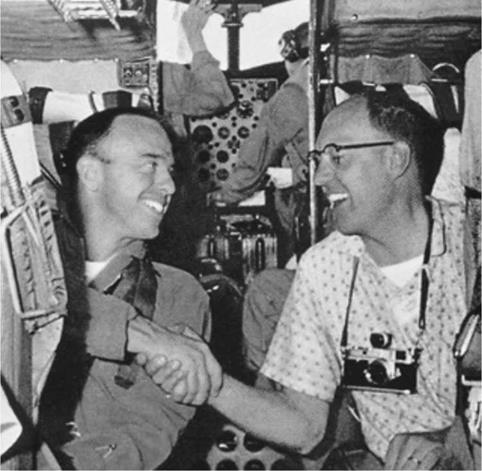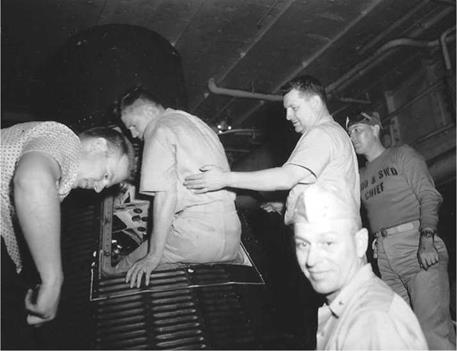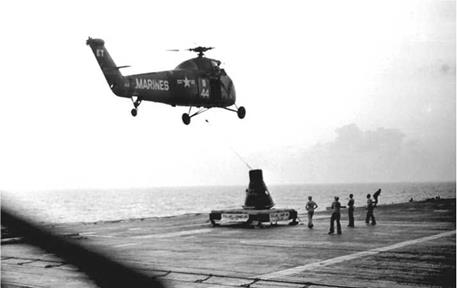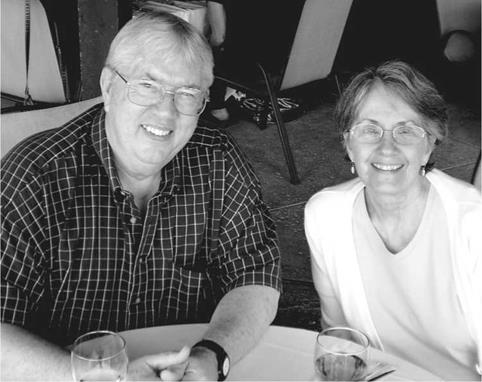THE SKIPPER AND A TIGHT SQUEEZE
Back on the USS Lake Champlain the spacecraft had been transferred below to the hangar bay, where Capt. Weymouth and his Executive Officer Cdr. Doner conferred briefly with Charles Tynan, NASA’s senior representative. Weymouth then climbed into Freedom 7 to get a feel for the cockpit, which he found was a little too small for him. He exited the hatch with the assistance of Cdr. Doner, who then took his turn to squeeze himself into the spacecraft.
![]()
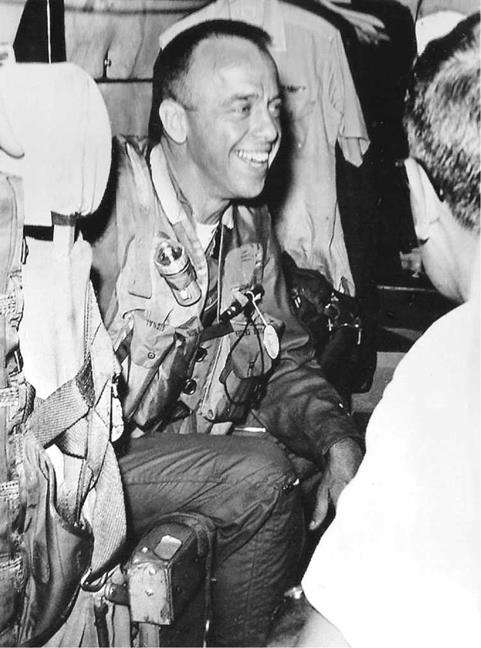
|
|
Astronaut meets photographer: Alan Shepard shakes hands with Dean Conger. (Photo courtesy of Dean Conger/NASA) |
After the ship had closed to within about eight miles of Florida during the night, Wayne Koons lifted off in Marine Corps helicopter #44 and as he hovered directly over Freedom 7 George Cox attached the harness to the spacecraft so that it could be ferried back to Cape Canaveral.
“The helicopter had to get very close to the capsule to connect the harness with the shepherd’s hook,” Ed Killian recalled. “Although that day one should really have renamed that apparatus a ‘Shepard’s hook.’ Anyway, the helo hovered, while the tension on the sling was taken up. The helo then moved to starboard over the capsule and lifted it clear of the platform. Helo and capsule were vectored toward the beach, accompanied by an escort. The platform that had held the capsule was then moved below as the helo and its package swung off into the distance. The capsule would be displayed for a period of time at Cape Canaveral.”
|
|
Capt. Weymouth exits the spacecraft with the assistance of Cdr. Landis Doner while Charles Tynan busies himself at left. (Photo courtesy of Ed Killian)
|
|
Pilot Wayne Koons eases Freedom 7 off the landing pad ahead of the delivery flight across to Cape Canaveral. (Photo courtesy of Ed Killian)
As Wayne Koons points out, “I don’t remember exactly where we set it down, but that’s when the news coverage came in earnest. There were print reporters and TV crews. At that time they did everything on sixteen-millimeter cameras. So they’d get us out with these cameras, and we did lots of interviews. It was a heady time.” [52] Despite Freedom 7 being the most celebrated piece of hardware in the world that day, its arrival at the Cape passed almost unheralded. Millions of television viewers had watched it ride atop the Redstone booster carrying Alan Shepard into space, but only 35 people – newsmen, engineers, guards – were on hand for its return. Set down just two miles from the launch pad that it had left the previous morning, Freedom 7 was given a brief examination and then hauled off to a hangar where, in the weeks to come, the engineers and technicians would go over it inch by inch.
For Ed Killian and the USS Lake Champlain, things quickly returned to normal. “That ended our participation in the first U. S. manned space flight and we headed home. It had been a long cruise, but we’d been a part of something truly historic.”
|
A recent photo of Ed and Kath Killian. (Photo courtesy of Ed Killian) |
Frank Yaquiant of Baltimore, Maryland agrees. He joined the carrier in May 1960 as a member of the V-4 division, responsible for the aviation fuel the planes used. “I was very happy to have been on ‘The Champ’ that day. My shipmates and I were witnesses to something truly special. It’s been almost 52 years since that memorable day, and the science of space travel has advanced far beyond that available during the flight of Freedom 7. The achievements of those past 50-plus years may make the events of May 5, 1961 seem rather modest to the uninformed [today]. But this was America’s first venture into manned space travel, and those of us aboard the USS Lake Champlain that day have the pride and satisfaction of knowing we were there at the beginning.” [53]
As a footnote to the story, about ten years after Shepard’s flight, Ed Killian was dining with his family at Vargo’s restaurant in Houston when he became aware that Alan Shepard had just walked in. As Shepard was talking to a party of people who had greeted him at the door, Killian decided to introduce himself and strolled over. “As I drew near, the crowd began to break up. I offered my hand and said, ‘Admiral, I’m Ed Killian, and we haven’t met, but you may remember ‘Mercury, Mercury, this is Nighthawk. Do you read?’ He smiled and said ‘How could I forget?’ Then his eyes narrowed as if remembering more of the details. ‘That was you?’ I nodded, smiling. ‘Hmmm,’ he said, ‘I was pretty excited, wasn’t I?’ He tilted his head and raised his eyebrows, as if to ask a further question. I sensed that he was making an oblique reference to the private conversation we had had. ‘You had a right to be excited. So did we all,’ I observed. Satisfied with my response, he said, ‘Well, very nice to meet you,’ nodding and shaking my hand. He then turned back to his party and they were ushered to his table. I knew there was a wild world of differences between us, but I also knew the two of us shared a secret.”











